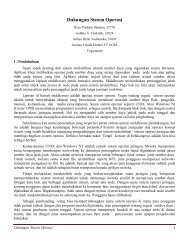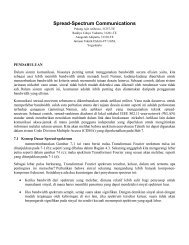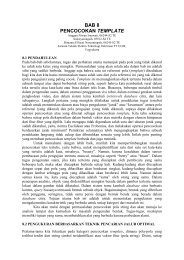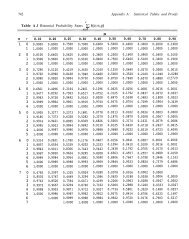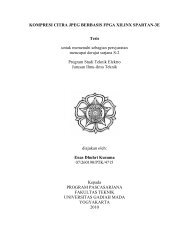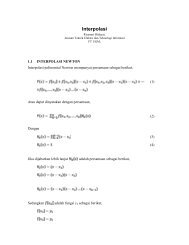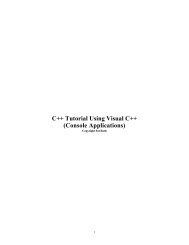Amplifiers
Amplifiers
Amplifiers
Create successful ePaper yourself
Turn your PDF publications into a flip-book with our unique Google optimized e-Paper software.
cMoS<br />
<strong>Amplifiers</strong><br />
Most CMOS amplifiers have identical bipolar counterparts and can therefore be<br />
analyzed in the same fashion. Our study in this chapter parallels the developments in<br />
Chapter 5, identifying both similarities and differences between CMOS and bipolar<br />
circuit topologies. It is recommended that the reader review Chapter 5, specifically,<br />
Section 5.1. We assume the reader is familiar with concept such as I/O impedances,<br />
biasing, and dc and small-signal analysis. The outline of the chapter is shown below<br />
e<br />
;r'.s<br />
GENERAT COI{SIDERATIOI{S<br />
7.1.1 MOS Amplifier Topologies<br />
Recall from Section 5.3 that the nine possible circuit topologies using a bipolar transistor<br />
in fact reduce to three useful configurations. The similarity of bipolar and MOS<br />
small-signal models (i.e., a voltage-controlled current source) suggests that the same<br />
must hold for MOS amplifiers. In other words, we expect three basic CMOS amplifiers:<br />
the "common-source"(CS) stage, the "common-gate"(CG) stage, and the<br />
"source follower."<br />
7.1,2 Biasing<br />
Depending on the application, MOS circuits may incorporate biasing techniques<br />
that are quite different from those described in Chapter 5 for bipolar stages. Most of<br />
these techniques are beyond the scope of this book and some methods are studied<br />
in Chapter 5. Nonetheless, it is still instructive to apply some of the biasing concepts<br />
of Chapter 5 to MOS stages.<br />
329
330 Chapter 7 CMOS <strong>Amplifiers</strong><br />
voo= 1'8v<br />
BD<br />
lD<br />
10 kO<br />
M1<br />
1 kc)<br />
Figure 7.1 MOS stage with biasing.<br />
consider the circuit shown in Fig. 7.1, where the gate voltage is deflned by R1<br />
and R2. We assume M1 operates in saturation. Also, in most bias calculations, we cal<br />
neglect channel-length modulation. Noting that the gate current is zero, we have<br />
Since[:VGs*IpRs,<br />
Also,<br />
v*: =P^ vro. '<br />
"<br />
R1*Rz "<br />
R"<br />
alf *vDD:vcs * IoRs'<br />
1W<br />
Io:)pnC*7wcs-Vru)2.<br />
(7.1<br />
(7.2r<br />
(i.r)<br />
Equations (7.2) and (7.3) can be solved to obtain Ip and. v74, either by iteration or<br />
by finding Ip from (7.2) and replacing for it in (7.3):<br />
That is,<br />
/ h \l r w<br />
(-F&=voo - u.t) -vru)'.<br />
*: )u,c*7(vcs<br />
(7.4<br />
v65 : -(v1- vru) . - ,t- . (7.5<br />
lrr, -r-r' #Er"rr.<br />
where<br />
I<br />
r p^r/^^<br />
''''\R,+R,<br />
: -(vt-vril * ,ln? +zv,( fzvpo= - v. \<br />
\<br />
"n)'<br />
(7.61<br />
I<br />
,,: e.,<br />
*r,+A.<br />
This value of v6 can then be substitute d in (7.2) to obtain ID. of course, Vy musr<br />
exceed Vx -Vrn to ensure operation in the saturation region.<br />
Determine^ the bias current of M1 in Fig.7.1 assumin1Vrn:0.5V, llnCo*:<br />
l:O yA(y'z, W/L 5/0.18, and ,1. : =<br />
0. What is rhe maximum altowabte vatue of<br />
Rp for M 1to remain in saturation?
7.1 General Considerations331<br />
Solution<br />
We have<br />
u*:<br />
ffivoo<br />
:1.296V.<br />
(7.8)<br />
(7.e)<br />
With an initial guess VGS :1 V, the voltage drop across R5 can be expressed as<br />
Vx - Vcs: 286 mV, yielding a drain current of 286 prA. Substituting for 12 in<br />
Eq. (7.3) gives the new value of V65 as<br />
Vcs : Vrn *<br />
2Io<br />
-w<br />
&nCo*| I,<br />
(7.10)<br />
Consequently,<br />
and hence<br />
:0.954V.<br />
a<br />
Vx - Vcs<br />
In:<br />
:332 p,A,<br />
Vcs : 0.989 V.<br />
(7.1r)<br />
(7.12)<br />
(7.13)<br />
(7.1,4)<br />
This gives Io :297 p,A.<br />
As seen from the iterations, the solutions converge more slowly than those<br />
encountered in Chapter 5 for bipolar circuits. This is due to the quadratic (rather<br />
than exponential) Ip-V6 dependence. We may therefore utilize the exact result in<br />
(7.6) to avoid lengthy calculations. Since Vt :0.36Y,<br />
VGS :0.974V<br />
(7.1s)<br />
and<br />
Io:<br />
Vx - Vcs<br />
(7.1.6)<br />
:312 p.A.<br />
(7.17)<br />
The maximum allowable value of R2 is obtained if Vy : Vx - Vrn : 0'786 V'<br />
That is,<br />
Vno - Vv<br />
RD:<br />
Ip<br />
:3.25k9.<br />
(7.18)<br />
(7.1e)<br />
Exercise<br />
What is the value of R2 that places M1 at theedge of saturation?
332 Chapter 7 CMOS <strong>Amplifiers</strong><br />
In the circuit of Example 7.1., assume Mt islui' saturation and R2:2.5ke and<br />
compute (a) the maximum allowable value of w /L and(b) the minimum allowable<br />
value of R5 (withW lL: 5/0.18). Assume .i.: 0.<br />
Solution<br />
(a) As W/Lbecomes larger, Ml cancafiy a larger current for a given V65. With<br />
Rn :2.5 kQ and Vx : 1.286 V, the maximum allowable value of 1p is given by<br />
, Vno -VY<br />
to:<br />
Ro<br />
:406 p.A.<br />
(7.20)<br />
(7.21)<br />
The voltage drop across R5 is then equal to 406 mV, yielding Vcs:I.2B6V-<br />
0.406 V : 0.88 V. In other words, M1 must carry a current of 406 prA with Vcs :<br />
0.88 V:<br />
-1,W Io :'rtt,C*|{vo, - Vrtl)z<br />
(7.22)<br />
406 p.A: (50prA/v'7\1o.zavf ,<br />
'L'<br />
(7.23)<br />
thus,<br />
w<br />
T :56'2'<br />
(7.24)<br />
(b) with w I L : 5 /0.1,8, the minimum allowable value of R5 gives a drain<br />
current of 406 pcA. Since<br />
Vcs : Vra *<br />
w<br />
P"C*T<br />
(7.2s)<br />
: 1.041V,<br />
the voltage drop across R5 is equal to Vy - V65 :<br />
Vx -Vcs<br />
/Kc:- ^<br />
"Ip<br />
:604 O.<br />
245 mY .It follows that<br />
(7.26)<br />
(7.27)<br />
(7.28)<br />
Exercise Repeat the above example if V7s :0.35 V.<br />
The self-biasing technique of Fig. 5.22 can also be applied to MoS amplifiers<br />
Depicted in Fig. 7 .2, the circuit can be analyzed by noting that Ml is in saturation<br />
(why?) and the voltage drop across R5 is zero. Thus,<br />
IoRn *Vcs I RsIo:Voo.<br />
(7.29r<br />
Finding V55 from this equation and substituting it in (7.3), we have<br />
,o:ttr,C*[Voo-<br />
(Rs* Rn)Io -Vrr7'<br />
(7.30 r
7.1 General Considerations 333<br />
Fisure 7.2 Self-biased MOS stage.<br />
T'oo<br />
?"o<br />
B6 l<br />
;rtrro<br />
-q'' t"'<br />
where channel-length modulation is neglected. It follows that<br />
Ir<br />
(Rs + Ro)2 Po - zl tvoo - vrn)(Rs+ Rots- -L--<br />
lro *,roo - vru)z : 0'<br />
I<br />
wnC^T )<br />
,r.r9<br />
Calculate the drain current of M1 inFig. T .3 lf p'nCo": 100 prA/Vz, Vrn - 0.5 V,<br />
and .i,: 0. What value of Rp is necessary to reduce Ip by a factor of two?<br />
Vps= 1.8 Y<br />
flD<br />
20 kQ<br />
1ko<br />
W5<br />
Mt T<br />
=oro<br />
200 f,<br />
Figure 7.3 Example of self-biased MOS stage.<br />
Solution<br />
Equation (7.31) gives<br />
Io:556 PtA.<br />
To reduce Ip to278 prA, we solve (7.31) for R2:<br />
RD :2.867 kf2.<br />
(7.32)<br />
(7.33)<br />
Exercise<br />
Repeat the above example if Voo drops to 1'2 V'<br />
7,1.3 Realization of Gurrent Sources<br />
MOS transistors operating in saturation can act as current sources. As illustrated in<br />
Fig. 7.4(a), an NMOS device serves as a current source with one terminal tied to<br />
ground, i.e., it draws current from node X to ground. On the other hand, a PMOS
334 Chapter 7 CMOS <strong>Amplifiers</strong><br />
x x vu{l,'"z+? T'o'-T'*<br />
vo*jff, i nr.lf*i'<br />
n.+c",*6<br />
r-LYY=X<br />
?:<br />
(a)<br />
(b)<br />
Figure 7.4 (a) NMOS device operating as a current source, (b) PMOS device operating<br />
as a current source, (c) PMOS topology not operating as a current source, (d) NMOS<br />
topology not operating as a current source.<br />
(c)<br />
J<br />
(d)<br />
transistor [Fig. 7.4(b)] draws current from Vpp to node Y. If )" : 0, these currents<br />
remain independent of Vy or Vy (so long as the transistors are in saturation).<br />
It is important to understand that only the drainterminal of a MOSFET can draw<br />
a dc current and still present a high impedance. SpecificCly, NMOS or PMOS devices<br />
configured as shown in Figs. 7.4(c) and (d) do not operate as current sources because<br />
variation ofVy or Vy directly changes the gate-source voltage of each transistor, thus<br />
changing the drain current considerably. From another perspective, the small-signal<br />
model of these two structures is identical to that of the diode-connected devices<br />
in Fig. 6.34, revealing a small-signal impedance of only llg* (if ), 0) rather than<br />
-<br />
infinity.<br />
COMMON.SOURCE STAGE<br />
7.2.1 GS Gore<br />
Shown in Fig. 7.5(a), the basic CS stage is similar to the common-emitter topologi<br />
with the input applied to the gate and the output sensed at the drain. For small signals<br />
M1 converts the input voltage variations to proportional drain current changes, and<br />
R;r transforms the drain currents to the output voltage. If channel-length modulation<br />
is neglected, the small-signal model in Fig. 7.5(b) yields u;, : u1 and l)ss1 : -ganlRp-<br />
That is,<br />
uout<br />
Ui,<br />
a result similar to that obtainedfor the<br />
*S^Rn, (7.341<br />
common emitter stage in Chapter 5.<br />
T'oo<br />
to?<br />
tnput Apptied/ +<br />
to Gate<br />
. tsVout<br />
n"Jfl"' \ outP''t s"n""o<br />
(a)<br />
(b)<br />
Figure 7.5 (a) Common-source stage, (b) small-signal mode.
7.2 Common-Source Stage 335<br />
The voltage gain of the CS stage is also limited by the supply voltage. Since g- :<br />
J2 p."C*(W I L)I o, we have<br />
zp,c*!tpno,<br />
(7.3s)<br />
concluding thattf Ip or.R;r is increased, so is the voltage drop across Ra ( : I2,Rp).'<br />
For Ml to remain in saturation,<br />
that is,<br />
Vno-RnIo.Vcs-Vrn,<br />
RoIo
336 Chapter 7 CMOS <strong>Amplifiers</strong><br />
The drain voltage is equal to Vpp - RoIo 0.8 V. Since Y65 -<br />
- Vrn : 0.6 V, the<br />
device indeed operates in saturation and has a margin of 0.2 V with respect to the<br />
triode region. For example, if Rp is doubled with the intention of doubling,4,,<br />
then M1 enters the triode region and its transconductance drops.<br />
Exercise<br />
What value of V7s places M1 atthe edge of saturation?<br />
Since the gate terminal of MOSFETs draws a zero current (at very low frequencies),<br />
we say the CS amplifler provides a current gain of infinity. By contrast, the<br />
current gain of a common-emitter stage is equal to B.<br />
Let us now compute the I/O impedances of the CS amplifier. Since the gate<br />
current is zero (at low frequencies),<br />
(7.44j<br />
a point of contrast to the CE stage (whose R2 is equal to ro). The high input<br />
impedance of the CS topology plays a critical role in many analog circuits.<br />
The similarity between the small-signal equivalents of CE and CS stages indicates<br />
that the output impedance of the CS amplifier is simply equal to<br />
This is also seen from Fis. 7.7.<br />
Rout: Ro.<br />
(7.4s)<br />
,,F<br />
?<br />
v1<br />
9*vt<br />
flD<br />
Figure 7.7 Output impedance of CS stage.<br />
In practice, channel-length modulation may not be negligible, especially if R2<br />
is large. The small-signal model of CS topology is therefore modified as shown in<br />
Fig. 7.8, revealing that<br />
A,:<br />
Rin:<br />
-g^(Rollro)<br />
@<br />
Rout: Rnllro.<br />
(7.46)<br />
(7.47)<br />
(7.48)<br />
In other words, channel-length modulation and the Early effect impact the CS and<br />
CE stages, respectively, in a similar manner.<br />
rtF-<br />
+<br />
v1<br />
Figure 7.8 Effect of channel-length modulation on CS stage.
7.2 Common-Source Stage 337<br />
Assuming M1 operates in saturation, determine the voltage gain of the circuit<br />
depicted in Fig. 7.9(a) and plot the result as a function of the transistor channel<br />
length while other parameters remain constant.<br />
Yin*--l<br />
(a)<br />
(b)<br />
Figure 7.9 (a) CS stage with ideal current source as a load, (b) gain as a function of device<br />
channel leneth.<br />
l<br />
Solution<br />
The ideal current source presents an infinite small-signal resistance, allowing the<br />
use of (7.a6) with ftn : oo:<br />
Au: -fl,mfo, (7.4e)<br />
This is the highest voltage gain that a single transistor can provide. Writing g- -<br />
JTnERtrDI; andro: ().1p)-1, we have<br />
This result may imply that<br />
)," a L-1:<br />
lA,l -<br />
^.^fi;<br />
(7.s0)<br />
1,4, I falls as L increases, but recallfrom Chapter 6 that<br />
lA,l o<<br />
2p,nCo*WL<br />
Ip<br />
Consequently,lA,l increases with ,L[Fig. 7.9(b)].<br />
(7.s1)<br />
Exercise Repeat the above example if a resistor of value Rr is tied between the gate and drain<br />
of M..<br />
7.2.2 CS Stage With Gurrent-Source Load<br />
As seen in the above example, the trade-off between the voltage gain and the voltage<br />
headroom can be relaxed by replacing the load resistor with a current source. The<br />
observations made in relation to Fig. 7.4(b) therefore suggesthe use of a PMOS<br />
device as the load of an NMOS CS amplifier [Fig. 7.10(a)].<br />
Let us determine the small-signal gain and output impedance of the circuit.<br />
Having a constant gate-source voltage, M2 simply behaves as a resistor equal to its<br />
output impedance [Fig.7.10(b)] because ur : 0 and hence gm2u1 :0. Thus, the drain<br />
node of M1 sees both re1 and 162 to ac ground. Equations (7.46) and (7.48) give<br />
A,:<br />
-5il(rotllroz)<br />
Rout : rorllroz.<br />
(7.s2)<br />
(7.s3)
338 Chapter 7 CMOS <strong>Amplifiers</strong><br />
i<br />
.,1 -- i<br />
r1:HH1: i<br />
,lFj<br />
,;<br />
Yino-l<br />
Yin4<br />
M1<br />
(a)<br />
(b)<br />
Figure 7.10 (a) CS stage using a PMOS device as a current source, (b) small-signal model.<br />
Figure 7.11 shows a PMOS CS stage using an NMOS currgnt source load. Compute<br />
the voltage gain of the circuit.<br />
voo<br />
Figure 7.'t 1 CS stage using an NMOS device as current source.<br />
Sofution<br />
Tiansistor Mz generates a small-signal current equal to gTTouin; which<br />
through r ot"llr oz, producing u o6 : - gm2v) in(r ollr oz). Thus,<br />
A,:<br />
-E*z(rorllro).<br />
then flows<br />
(7.s4)<br />
Exercise<br />
Calculate the gain if the circuit drives a loads resistance equal to R;.<br />
7.2.3 GS Stage With Diode-Gonnected Load<br />
In some applications, we may use a diode-connected MOSFET as the drain load.<br />
Illustrated in Fig. 7.12(a), such a topology exhibits only a moderate gain due to the<br />
relatively low impedance of the diode-connected device (Section 7.7.3). With ). : 0,<br />
M2 acls as a small-signal resistance equal to L l gnp, and (7.34) yields<br />
1<br />
Au: -8m1.' -<br />
8"a<br />
J'NE;@TDJ;<br />
JTNE;OTTDJ;<br />
(wlL)t<br />
(wlL)z<br />
(7.ss)<br />
(7.s6<br />
(7.s7
7.2 Common-Source Stage 339<br />
Figure7.12,"l ioo, stage using<br />
" o,oa"-"ol?"cted load, (b) bipolar *t,lllro"rt,<br />
(c) simplifled circuit of (a).<br />
Interestingly, the gain is given by the dimensions of M1 and M2 and remains independent<br />
of process parameters p.n andCo, and the drain current, 12.<br />
The reader may wonder why we did not consider a common-emittel stage with<br />
a diode-connected load in Chapter 5. Shown r* Fig. 7.12(b), such a circuit is not used<br />
because it provides a voltage gain of only unity:<br />
1,<br />
Ar: -$mI -<br />
8mZ<br />
Icr 1<br />
Vr. IczlVr<br />
x -1.<br />
(7.60)<br />
(7.s8)<br />
(7.se)<br />
The contrast between (7.57) and (7.60) arises from a fundamental difference between<br />
MOS and bipolar devices: transconductance of the former depends on device<br />
dimensions whereas that of the latter does not.<br />
A more accurate expression for the gain of the stage in Fig. 7.12(a) must take<br />
channel-length modulation into account. As depicted in Fig. 7.12(c), the resistance<br />
seen at the drain is now equal to (1lg^z)llroz11161, and hence<br />
/t' \<br />
A, : - gnt<br />
\-llr<br />
ozllr ot ).<br />
Similarly, the output resistance of the stage is given by<br />
(7.61)<br />
Ro,t: Lllrorllror.<br />
8m2<br />
(7.62)<br />
-I Ifll[f Determine the voltage gain of the circuit shown in Fig' 7.13(a) if L + 0'<br />
E<br />
Yi"*l<br />
Figure 7.1 3 CS stage with diode-connected PMOS device.
340 Chapter 7 CMOS <strong>Amplifiers</strong><br />
Solution<br />
This stage is similar to that in Fig. 7.72(a), but with NMOS devices changed to<br />
PMOS transistors: M1 serves as a common-source device and Mt as a diodeconnected<br />
load. Thus.<br />
A,: -gm2(*u"'ll'or)'<br />
(7.63)<br />
Exercise<br />
Repeat the above example if the gate of M1 is tied to a constant voltage equal to<br />
0.5 v.<br />
7.2.4 CS Stage With Degeneration<br />
Recall from Chapter 5 that a resistor placed in series with the emitter of a bipolar<br />
transistor alters characteristicsuch as gain,Ilo impedarces, and linearity. we expect<br />
similar results for a degenerated CS amplifier.<br />
Figure 7.14 (a) CS stage with degeneration, (b) small-signal model.<br />
Figure 7.14 depicts the stage along with its small-signal equivalent (if ), : 0). As<br />
with the bipolar counterpart, the degeneration resistor sustains a fraction of the input<br />
voltage change. From Fig. 7.1.4(b), we have<br />
l)in:<br />
Ul * g*u1R5<br />
(7.64)<br />
and hence<br />
uin<br />
,,:1+g;Rr.<br />
(7.6s)<br />
Since g-u1 flows through Rp, t)6y7 - -gaulRp and<br />
I)out _ _ 8*Rn<br />
'uin 1 * g-Rg<br />
: -<br />
Rp<br />
I *or'<br />
8^<br />
a result identical to that expressed by (5.157) for the bipolar counterpart.<br />
(7.66)<br />
(7.67)
7.2 Common-Source Stage 341<br />
Ī<br />
a.+:lrrl.lt:I<br />
ffiComputethevoltagegainofthecircuitshowninFig.7.15(a)if)":0.<br />
vin4<br />
1<br />
9mz<br />
(a,<br />
Fisure 7.15 (a) Example of CS stage with degeneration, (b) simplified circuit.<br />
(b)<br />
Sofution<br />
Exercise<br />
Tiansistor M2 sewes as a diode-connectedevice, presenting an impedance of<br />
1.1g",21Eig.7.15(b)]. The gain is therefore given by (7.67)it R5 is replaced with<br />
r/g'a:<br />
What happens if ), t' 0 for M2?<br />
R.t<br />
a -_ "<br />
11<br />
_+_<br />
9mr 9r,a<br />
(7.68)<br />
In parallel with the developments in Chapter 5, we may study the effect of a<br />
resistor appearing in series with the gate (Fig. 7.16). However, since the gate current<br />
is zero (at low frequencies), R5 sustains no voltage drop and does not affect the<br />
voltage gain or the I/O impedances.<br />
Effect of Transistor Output lrnpedance As with the bipolar counterparts, the<br />
inclusion of the transistor output impedance complicates the analysis and is studied<br />
in Problem 31. Nonetheless, the output impedance of the degenerated CS stage plays<br />
a critical role in analog design and is worth studying here.<br />
Figure 7.17 shows the small-signal equivalent of the circuit. Since R5 carries a<br />
current equal to 176 (why?), we have q : -ixRs. Also, the current throttghro is equal<br />
Figure 7.16 CS stage with gate resistance.
342 Chapter 7 CMOS <strong>Amplifiers</strong><br />
,rF<br />
f<br />
,!<br />
T<br />
l<br />
Figure 7.17 Output impedance of CS stage with degeneration.<br />
to iv - gmuL : ix - B^GiyR5) : ix * g*ixRs. Adding the voltage drops across rp<br />
and R5 and equating the result to ux, we have<br />
and hence<br />
ro(ix * g-ixRs) * iaRs : yy,<br />
UY<br />
,.:ro(1<br />
LX<br />
+g-Rs)+Rs<br />
: (1 + g^ro)Rs * ro<br />
(7.6e)<br />
(7.70)<br />
(7.71)<br />
x g*rsRs * ro.<br />
(7.72)<br />
Alternatively, we observe that the model in Fig. 7.I1 is similar to its bipolar counterpart<br />
in Fig. 5A6@) but with ro : oo. Lettin Ern --> oo in Eqs. (5.196) unO 1S.tlZ; yi"ta,<br />
the same results as above. As expected from our study of the bipolar degenerated<br />
stage, the MOS version also exhibits a ,,boosted" output impedance.<br />
compute the output resistance of the circuit in Fig. 7.1g(a) if M1 and, M2 are<br />
identical.<br />
[- Fout<br />
T'<br />
Yo*.|lnrr<br />
--t 1ryil,<br />
;<br />
(a)<br />
l- Fout<br />
?V<br />
,,r-{f*,o,<br />
*'l<br />
f fi,"'",<br />
;<br />
(b)<br />
Figure 7.18 (a) Example of cS stage with degeneration, (b) simplified circuit.<br />
Solution<br />
The diode-connectedevice M2 can be represented by a small-signal resistance<br />
of (l/g"a)llroz x 118-2. Tiansistor M1 is degenerated by this resistance, and from<br />
(7.70):<br />
1<br />
Rout: ror(1+ r^*) * (7.73)<br />
8*z
7.2 Common-Source Stage 343<br />
which, since g-t : gnD: g., reduces to<br />
Rort:Zror+L (7.74)<br />
8*<br />
x 2ror.<br />
Q.75)<br />
Exercise Do the results remain unchanged lf Mz isreplaced with a diode-connected PMOS<br />
device?<br />
Determine the output resistance of the circuit in Fig. 7.1-9(a) and compare the result<br />
with that in the above example. Assume M1 and M2 are in saturation.<br />
?Y I<br />
voz4\tr',<br />
I<br />
vot 4E M,<br />
I ;<br />
(a)<br />
[- Rout *<br />
[- Fout<br />
?V<br />
t-r<br />
,,HE *ro,<br />
'' t-<br />
* ro,<br />
;<br />
o)<br />
Figure 7.19 (a) Exampte of CS stage with degeneration, (b) simplified circuit.<br />
Solution<br />
With its gate-source voltage flxed, transislor M2 operates as a current source, introducing<br />
a resistance of r 62 ftomthe source of M1 to ground [Fig. 7.19(b)].<br />
Equation (7.71) can therefore be written as<br />
Rout : (I * gnro)roz I rot Q.76)<br />
N gmtrorro2 + ro1. Q '77)<br />
Assuming Smrroz ) 1 (which is valid in practice), we have<br />
Rout N gmtrolroz.<br />
We observe that this value is quite higher than that in (7.75).<br />
Q.78)<br />
Exercise Repeat the above example for the PMOS counterpart of the circuit.<br />
7.2.5 GS Gore With Biasing<br />
The effect of the simple biasing network shown in Fig. 7.1 is similar to that analyzed for<br />
the bipolar stage in Chapter 5. Depicted in Fig. 7.20(a) along with an input coupling<br />
capacitor (assumed a short circuit), such a circuit no longer exhibits an infinite input<br />
impedance:<br />
Rin: RtllRz.<br />
(7.7e)
344 Chapter Z CMOS <strong>Amplifiers</strong><br />
voo<br />
voo<br />
(a)<br />
G) {c}<br />
t11 (a) cS stage<br />
:l1ll"<br />
with input coupling capaciror, (b)<br />
(c)<br />
incrusion<br />
use of bypass<br />
of gate<br />
capacitor.<br />
resistance,<br />
ffiui,:i:<br />
circuit is driven bv a finite source impedange fFig.7.z0(b) r, the vortage<br />
a RrllRz<br />
-<br />
-Rp<br />
--' : pol ft1lRz l :<br />
(7.80)<br />
-<br />
s- +Rt<br />
where .1, is assumed to be zero.<br />
As mentioned in chapler 5, it is possibre to_utilize degeneration<br />
stability for<br />
but eliminate<br />
bias point<br />
its eifect on the small-signut p"rro.*u-i""<br />
capacitor<br />
i] *"ur* of a bypass<br />
[Fig' 7'20(c)], the case of !$ike<br />
bipolar realizarion,<br />
input<br />
)<br />
this does<br />
impedance<br />
not alter<br />
of the<br />
the<br />
CS staee:<br />
I-<br />
Err<br />
Ef<br />
but raises the voltage gain:<br />
R;" : RrllRz,<br />
(7.81)<br />
RtllRz<br />
,a' ^ : -F;T Rr ilE 8^Rn' (7.82)<br />
Desiqn the cS stage of Fig. 7.20(cXor a voltage gain of 5, an<br />
50 input<br />
kd, impedance<br />
anda powJr<br />
of<br />
b"dg;; of 5'mW arr'_Jrric,, : 100 p.A/yr, vir: 0.5 v,<br />
'l' = 0, andVpp: 1.8 V. Also, assume a voltage drop of 400 mV across R(.<br />
solution<br />
The power budget along with vno..= 1.8 v implies a maximum supply current of<br />
2'78 mA' As an initial guess, we allocate 2.7 ;A to M1 andthe rem'aining s0 pcA<br />
to R1 and R2. It follows that<br />
Rs : 148 Q.<br />
(7.83)<br />
As with typical design problems, the choice of g* and,R2<br />
so<br />
is<br />
long<br />
somewhat<br />
as g*Rp :<br />
flexible<br />
5. However, with 12 known, we must ensure<br />
for<br />
a<br />
765,<br />
reasonabre<br />
e.8., Vcs:<br />
value<br />
1 V. This choice yields<br />
2In<br />
Vcs - Vru<br />
1<br />
92.6c"'<br />
(7.84)<br />
(7.8s)
7.3 Common-Gate Stage 345<br />
and hence<br />
Writing<br />
Ro:4639'<br />
_ 1<br />
Io:ip,C^7tV.t-Vrn)'<br />
^W<br />
(7.86)<br />
(7.87)<br />
glves<br />
y:no.<br />
L<br />
With tr/65 : 1V and a 400-mV drop across R5, the gatevoltage reaches 1.4 V,<br />
requiring that<br />
R2 r,<br />
nt a *Voo:'L'4V'<br />
which, along with R;, : RrllRz: 50 k$), yields<br />
Rr : 64'3 kQ<br />
Rz:225k9.<br />
(7.88)<br />
(7.8e)<br />
(7.e0)<br />
(7.e1)<br />
We must now check to verify that Mt indeed operates in saturation. The drain<br />
voltage is given by Voo - InRo: l-.8 V - 1.25 V : 0.55 V. Since the gate voltage<br />
is equal to 1.4 Y the gate-drain voltage difference exceeds V7s, driving Ml into<br />
the triode region!<br />
How did our design procedure lead to this result? For the given Ip, we have<br />
chosen an excessively large Rp,i.e., an excessively small g- (because S^Ro:5).<br />
even though tr/65 is reasonable. We must therefore increase g. so as to allow a lower<br />
value for R2. For example, suppose we halve R2 and double g- by increasingW lL<br />
by a factor of four:<br />
w<br />
(7.e2)<br />
- :864<br />
L,<br />
6m-<br />
46.3rj"'<br />
The correspondingate-source voltage is obtained from (7.84):<br />
Vcs:250mV'<br />
(7.e3)<br />
{7.e4)<br />
yielding a gate voltage of 650 mV.<br />
Is M1 in saturation? The drain voltage is equal to Voo - RoIn:1.17Y, a<br />
value higher than the gate voltage minus V7s. Thus, M1 operates in saturation.<br />
Exgrcise Repeat the above example for a power budget of 3 mW and Vpp : L.2Y .<br />
v.ffi<br />
COMMON.GATE STAGE<br />
Shown in Fig. 7.2\, the CG topology resembles the common-base stage studied in<br />
Chapter 5. Here, if the input rises by a small value, AV, then the gate-source voltage<br />
of M1 decreases by the same amount, thereby lowering the drain current by g*LV
346 Chapter 7 CMOS <strong>Amplifiers</strong><br />
tnput Apptied/<br />
to Source<br />
Figure'1.21 Common-gate stage.<br />
T'oo<br />
?'o<br />
F Vout<br />
/u.,lFno \ou,oursensed<br />
Vin#<br />
at Drain<br />
and raising Vou, by g*LV Rp. That is, the voltage gain is positive and equal to<br />
Ar:<br />
g^Rp.<br />
The CG stage suffers from voltage headroom-gain trade-offs similar to those -r<br />
the CB topology. In particular, to achieve a high gain, a high 1p or Rp is necessa:tr<br />
but the drain voltage, Vno - IoRo, must remain above Va -Vrn to ensure M, li<br />
saturated.<br />
A microphone having a dc level of zero drives a CG stage biased at Ip - 0.5 mA.<br />
It W I L : 50, ptnCo* : 100 pAlYz, Vra : 0.5 V, and Vpp : 1.8 V, determine the<br />
maximum allowable value of Rp and hence the maximum voltage gain. Neglect<br />
channel-lensth modulation.<br />
Solution<br />
WifhW lL known, the gate-source voltage can be determined from<br />
,o :'rr,c^!rro, - vrn)t (7.96t<br />
AS<br />
For M1 to remain in saturation,<br />
Vcs -- 0.947 Y.<br />
(7.e7 t<br />
and hence<br />
Vnn-IoRo>Vn-Vt.u<br />
RD
7.3 Common-Gate Stage 347<br />
V6 = 0.947 V<br />
Figure 7.22 Signalevels in CG stage.<br />
We now compute the I/O impedances of the CG stage, expecting to obtain results<br />
similar to those of the CB topology. Neglecting channel-length modulation for now,<br />
we have from Fig. 7.23(a) ur : -ux and<br />
iy:<br />
-grdlt<br />
(7.101)<br />
(7.102)<br />
: $mUX.<br />
That is,<br />
R,n: L, (7.103)<br />
8m<br />
a relatively low value.Also, from Fig.l.23(b),u1 : 0 and hence<br />
Rou : RD,<br />
Q.L04)<br />
an expected result because the circuits of Figs. 7.23(b) and7.7 are identical.<br />
Let us study the behavior of the CG stage in the presence of a finite source<br />
impedance (Fig. 7.2q but still with ). : 0. In a manner similar to that depicted in<br />
Chapter 5 for the CB topology, we write<br />
1,<br />
g-<br />
UX: -T:-Uin<br />
(7.10s)<br />
:+R.s<br />
8*<br />
1,<br />
- -tl.<br />
1+ g^Rs"'n'<br />
(7.106)<br />
(a)<br />
Figure 7.23 (a) Input and (b) output impedances of CG stage.
348 Ghapter 7 CMOS <strong>Amplifiers</strong><br />
Uout<br />
FYo<br />
Fs vx<br />
-{!1--<br />
"'"Ql<br />
Figure7.24 Simplification of CG stage with signal source resistance.<br />
E=<br />
+*<br />
Thus,<br />
Uout<br />
uin<br />
uout .<br />
uX<br />
UX Uin O<br />
(7.ru7)<br />
8^Ro<br />
1*g-Rs<br />
(7.108)<br />
Ro<br />
: -l--'<br />
(7.1@)<br />
-+Rs<br />
8m<br />
The gain is therefore equal to that of the degenerated CS stage except for a negative<br />
sign.<br />
In contrast to the common-source stage, the CG amplifier exhibits a current gain<br />
of unity: the current provided by the input voltage source simply flows through the<br />
channel and emerges from the drain node.<br />
The analysis of the common-gate stage in the general case, i.e., including both<br />
channel-length modulation and a finite source impedance, is beyond the scope of<br />
this book (Problem 4L). However, we can make two observations. First, a resistance<br />
appearing in series with the gate terminal [Fig. 7.25(a)] does not alter the gain or vo<br />
impedances (at low frequencies) because it sustains a zero potential drop-as if its<br />
value were zero. Second, the output resistance of the CG stage in the general case<br />
[Fig. 7.25(b)] is identical to that of the degenerated CS topology:<br />
Rout:(I+g*ro\Rs+ro. (7.110)<br />
(a)<br />
(b)<br />
Figure 7.25 (a) cG stage with gate resistance, (b) output resistance of cG stage.
7.3 Common-Gate Stage 349<br />
For the circuit shown in Fig. 7 .26(a), calculate the voltage gain if ). : 0 and the<br />
output impedance if ). > 0.<br />
vpo<br />
RD<br />
Vout<br />
vb<br />
Figure 7.26 (a) Example of CG stage, (b) equivalent'lnput network, (c) calculation of<br />
output resistance.<br />
We first compute uyf u;nwith the aid of the equivalent circuit depicted in Fig.<br />
7.26(b):<br />
1ll 1<br />
UX c*llc^<br />
(7.111)<br />
wtn<br />
1il1<br />
:ll: +ns<br />
4mz ll 9mt<br />
Noting that uouyf uy : gmrRD, we have<br />
1<br />
1-t (g^t * g"a)Rs<br />
(7.112)<br />
uout<br />
,^:<br />
SnRn<br />
l+@^1 +g,,rfu<br />
(7.1.r3)<br />
To compute the output impedance, we first consider R6ys1, as shown in Fig.<br />
7.26(c), which from (7.110) is equal to<br />
Routt : (t* s*tro) (fitlr-tt^r) * ro'<br />
N s-rot(a rror) * rot.<br />
\4mz /<br />
The overall output impedance is then given by<br />
Rout<br />
- Rou*llRo<br />
r / 1 \ 'lll<br />
xlB^tror { - llRs}+rp1 llln2.<br />
L \8-z / lll<br />
(7.114)<br />
(7.11s)<br />
(7,1.1,6)<br />
(7.1r7)<br />
Exercise<br />
Calculate the output impedance if the gate of M2 is tied to a constant voltage.
350 Chapter 7 CMOS <strong>Amplifiers</strong><br />
7.3.7 GG Stage With Biasing<br />
Following our study of the cB biasing in chapter 5, we surmise the cG amplifier<br />
can be biased as shown in Fig. 7.27.Providing a path for the bias current to ground.<br />
resistor R3 lowers the input impedance-and hence the voltage gain-if the signal<br />
source exhibits a finite output impedance, R5.<br />
voo<br />
R1<br />
Bs<br />
vin"-tr!H<br />
Figure 7.27 CG stage with biasing.<br />
Since the impedance seen to the right of node X is equal to full(Ilg),<br />
we have<br />
Uout<br />
uin<br />
uX .<br />
Uout<br />
uin<br />
Dx<br />
(7.118)<br />
Rzll(1/s^)<br />
'**Rn,<br />
(7.11e)<br />
&ll(Ils; + Rs<br />
where channel-length modulation is neglected. As mentioned earlier, the voltage<br />
divider consisting of R1 and R2 does not affect the small-signal behavior of the circuit<br />
(at low frequencies).<br />
Design the common-gate stage of Fig. 7.27 for the following parameters: voulf<br />
1)in : 5, Rs - 0, R: : 500 {2, I/g^: 50 Q, power budget : 2mW, Voo :1.8Y.<br />
Assume &nCor:100 p,A/Yz,Vra :0.5 V, and l. : 0.<br />
Solution<br />
From the power budget, we obtain a total supply current of 1.11 mA. Allocating<br />
10 pA to the voltage divider, R1 and R2, we leave 1.1 mA for the drain current of<br />
M1. Thus, the voltage drop across R3 is equal to 550 mV.<br />
We must now compute two interrelated parameters: W/L and Ra. A larger<br />
value ofW lL yields a greatet gm,allowing a lower value of R2. As in Example j.1,j,,<br />
we choose an initial value for v6s to arrive at a reasonable guess for W lL.For example,if<br />
V65 - 0.8 V, thenW/L :244,and g*:2Inl(Vcs - Vrn): (136.4 e)-1,<br />
dictating Ro : 682f2 for uou.f u;, : 5.<br />
Let us determine whether M1 operates in saturation. The gate voltage is equal<br />
to V1;s plus the drop across R3, ilmourrting to 1.35 V. On the other hand, the<br />
drain voltage is given by Von - IoRo: 1.05 V. Since the drain voltage exceeds<br />
Vc - Vrn, Mt is indeed in saturation.
7.4 Source Follower 3F1<br />
The resistive divider consisting of R1 and R2 must establish a gate voltage equal<br />
to 1.35 V while drawing 10 prA:<br />
Vno<br />
: 10 pr.A<br />
(7.120)<br />
Rr*Rz<br />
R,<br />
n'<br />
-t<br />
*Voo : l'35 V'<br />
It follows that Ri : 45 kO and R2 : 135 kS2.<br />
(7.121)<br />
Hxercise<br />
nW/L cannot exceed 100, what voltage gain can be achieved?<br />
re<br />
.g.E-<br />
rE<br />
re<br />
Suppose in Example 7.1.4,we wish to minimize w lL (and hence transistor capacitances).<br />
What is the minimum acceptable valug of W lL?<br />
Solution<br />
For a given 1p , asW I L decreases, Vcs - Vra increases. Thus, we must first compute<br />
the maximum allowable V65. We impose the condition for saturation as<br />
Von - InRo > Vcs * Vnz - Vrn, (7.122)<br />
where I/p3 denotes the voltage drop across R3, and set g*Rp to the required gain:<br />
=,21'== RD:At.<br />
Vcs - Vru-''<br />
Eliminating R2 from (7.122) and (7.123) gives:<br />
(7.123)<br />
and hence<br />
In other words,<br />
It follows that<br />
vno -!v.,<br />
-vra) > vcs -vrn *vnz<br />
\r Vno - Vnz<br />
vGS_vrH._T;.<br />
wlL,<br />
2In<br />
2 ''<br />
u,c*(z\ff)'<br />
w/L > 172.5.<br />
(7.724)<br />
(7.12s)<br />
(7.126)<br />
(7.127)<br />
Exerc?se Repeat the above example for,4, : lQ.<br />
P.S,<br />
SOURCE FOTLOWER<br />
The MOS counterpart of the emitter follower is called the "source follower" (or the<br />
"common-drain" stage) and shown in Fig. 7.28.The amplifier senses the input at the<br />
gate and produces the output at the source, with the drain tied to Voo. The circuit's<br />
behavior is similar to that of the bipolar counterpart.
352 Chapter 7 CMOS <strong>Amplifiers</strong><br />
Input Applied<br />
to Gate<br />
Figure 7.28 Source follower.<br />
Yin"-{<br />
T'oo<br />
8,,<br />
F<br />
ltt<br />
F<br />
vou,<br />
\ourpur sensed<br />
atSource<br />
7.4,1 Source Follower Gore<br />
If the gate voltage of My in Fig. 7.28 is raised by a small amount, LVin,the gate-source<br />
voltage tends to increase, thereby raising the source current and hence the outpur<br />
voltage. Thus, Vrrl "follows" V;n. Since the dc level of 7r4 is lower than that of V;<br />
by Vcs, we say the follower can serve as a "level shift" circuit. From our analysis of<br />
emitter followers in Chapter 5, we expect this topololy to exhibit a subunity gain.<br />
too.<br />
Figure 7.29(a) depicts the small-signal equivalent of the source follower, including<br />
channel-length modulation. Recognizing that rs appears in parallel with R1, l*-e<br />
have<br />
Also,<br />
It follows that<br />
Smur(rollRL) : ,ou,.<br />
Dout<br />
uin<br />
uin=ul *uout.<br />
8^(rollRL)<br />
1- * g*(r6llR1)<br />
rollRr<br />
1<br />
I + rollRr<br />
8^<br />
(7.128t<br />
(7.129t<br />
(7.130r<br />
(7.131\<br />
The voltage gain is therefore positive and less than unity. It is desirable to maximize<br />
R; (and rp).<br />
As with emitter followers, we can view the above result as voltage division between<br />
a resistanc equal to 1/g^ and another equal to rollRr [Fig. 7.29(b)]. Nore"<br />
however, that a resistance placed in series with the gate does not affect (7.131)(at<br />
low frequencies) because it sustains a zero drop.<br />
1<br />
9m<br />
;lMrffvout<br />
"'"Q] f ".tr'o<br />
(a)<br />
(b)<br />
Figure 7.29 (a) Small-signal equivalent of source follower, (b) simplifled circuit.
7.4 Source Follower 353<br />
A source follower is realized as shown in Fig. 7.30(a), where M2 serves as a current<br />
source. Calculate the voltage gain of the circuit.<br />
4n'{<br />
4n'--{<br />
M1<br />
Yo*{<br />
(a)<br />
Figure 7.30 (a) Follower with ideal current source, (b) simplifled circuit.<br />
(b)<br />
Sofution<br />
Since M2simply presents an impedanc" of l,oifro- the output node to ac ground<br />
[Fig. 7.30(b)], we substitute R; : rozin Eq. (7.131):<br />
Au:<br />
If relllrs2) 1/g^r, thenA, * l.<br />
rollroz<br />
1,<br />
- + rotllroz<br />
8ml<br />
(7.132)<br />
Exercise Repeat the above example if a resistance of value R5 is placed in series with the<br />
source of Mt.<br />
Design a source follower to drive a 50-Q load with a voltage gain of 0.5 and a<br />
power budget of 10 mW. Assume FnCox :1.00 p.AlYz, Vrn :0.5 V, i. : 0, and<br />
Voo:1.8Y.<br />
Solution<br />
With Rr : 50 O and 16 : oo in Fig.7 .28, we have<br />
a--<br />
tLD -<br />
Rr<br />
1<br />
-l- + Rr<br />
8m<br />
and hence<br />
1<br />
8-:<br />
(7.134)<br />
50e'<br />
The power budget and supply voltaggllglq 3 rn4mum supply current of 5.56 mA.<br />
Using this value for Ip in g^: J2p."C*(W lL)Ip gives<br />
W/L :360.<br />
(7.r33)<br />
(7.13s)<br />
Exercise What voltage gain can be achieved if the power budget is raised to 15 mW?
356 Chapter 7 CMOS <strong>Amplifiers</strong><br />
It follows from (7.141) that<br />
w<br />
L<br />
L07. (7.rs2)<br />
Exercise What voltage gain can be achieved itW lL cannot exceed 50?<br />
Equation (7.140)<br />
reveals that the bias current of the source follower varies with<br />
the supply voltage. To avoid this effect, integrated circuits bias the follower by mean.<br />
of a current source (Fig. 7.33).<br />
vin'-l<br />
+<br />
Yin"--l<br />
c2<br />
c2<br />
F Vout F Vout<br />
Figure 7.33 Source follower with biasing.<br />
y.ffi{<br />
SUilIMARY AND'IOIIITIONAT frXAIWFTMS<br />
In this chapter, we have studied three basic CMOS building blocks, namely, th.<br />
common-source stage, the common-gate stage, and the source follower. As observe;<br />
throughout the chapter, the small-signal behavior of these circuits is quite similar tc<br />
that of their bipolar counterparts, with the exception of the high impedance seen a:<br />
the gate terminal. We have noted that the biasing schemes are also similar, with tho<br />
quadratic In-Vcs relationship supplanting the exponential 16-Vps characteristic.<br />
In this section, we consider a number of additional examples to solidify th.<br />
concepts introduced in this chapter, emphasizing analysis by inspection.<br />
-<br />
HtI<br />
Calculate the voltage gain and output impedance of the circuit shown in Fig. 73a@).<br />
(a)<br />
(b)<br />
Figure 7"34<br />
(a) Example of CS stage, (b) simplified circuit.
7.5 Summary and Additional Examples 357<br />
Sof ution<br />
We identify M1 as a common-source device because it senses the input at its gate<br />
and generates the output at its drain. Tiansistors M2 and M3 therefore act as the<br />
load, with the former serving as a current source and the latter as a diode-connected<br />
device. T}rtrs, M2 can be replaced with a small-signal resistance equal to re2, &rrd<br />
Mz with another equal to (1/Srs)llroz. The circuit now reduces to that depicted in<br />
Fig.73a(b), yielding<br />
Au: -$m1<br />
(fitv"'n,o,tt,o,) (7.1s3)<br />
and<br />
Note that 1,/9,6 is dominant in both expressions.<br />
Rout : lllrorllrozllroz. (i.154)<br />
8^z<br />
Exercise Repeat the above example if Mzis converted to a diode-connectedevice.<br />
Compute the voltage gain of the circuit shown in Fig. 7.35(a). Neglect channellength<br />
modulation in Mr.<br />
4nd<br />
Yo-{<br />
vpo<br />
Ms<br />
M1<br />
Vout<br />
M2<br />
lr<br />
4n,_-lf nr1<br />
fitt.o,<br />
Vout<br />
(a)<br />
Figure 7.35 (a) Example of CS stage, (b) simplifled circuit.<br />
(b)<br />
Sof ution<br />
Operating as a CS stage and degenerated by the diode-connectedevice M3,Iransistor<br />
M1 drives the current-source load, M2. Simplifying the amplifier to that in<br />
Fig.7.35(b), we have<br />
a<br />
-_<br />
r02<br />
71<br />
- + -llroz<br />
8m1. 8"a<br />
(7.1ss)<br />
Exercise<br />
Repeat the above example if the gate of M3 is tied to a constant voltage.
358 Chaoter 7 CMOS <strong>Amplifiers</strong><br />
Determine the voltage gain of the amplifiers illustrated in Fig. 7.36.For simplicitl'.<br />
assume rot : Q in Fig. 7.36(b).<br />
Yind<br />
Yo'-l<br />
M.l<br />
M1<br />
(a.)<br />
(b)<br />
Fisure 7.3s Examples of (a) CS and (b) CG stages.<br />
Sofution<br />
Exereise<br />
Degenerated by R5, transistor M1 in Fig. 7.36(a) presents an impedance of<br />
(I * g*1rs1)Rs * rot to the drain of M7 Thus the total impedance seen at the<br />
drain is equal to l(1" -f g*trot)Rs * ror]llr 02, giving a voltage gain of<br />
A, : - E*z{f(l * g*tr ot)Rs + ror] | lror}. (7.1s61<br />
In Fig. 7.36(b),M1 operates as a common-gate stage and M2 as the load, obtaining<br />
(7.10e):<br />
^<br />
11,,) : =--.<br />
roz<br />
t +R,<br />
8*r<br />
Replace R5 with a diode-connected device and repeat the analysis.<br />
(7.157 r<br />
n<br />
Ifllfl Calculate the voltage gain of the circuit shown in Fig. 7 .37(a) if i. : 0.<br />
vop<br />
RD<br />
Vout<br />
vb<br />
vin<br />
(al<br />
(b)<br />
Figure 7.37<br />
(a) Example of a composite<br />
stage, (b) simplified circuit.
7.5 Summary and Additional Examples 3S$<br />
Solution<br />
In this circuit, M1 operates as a source follower and M2 as a CG stage (why?). A<br />
simple method of analyzing the circuit is to replace uia &nd M1 with a Thevenin<br />
equivalent. From Fig. 7.29(b), we derive the model depicted in Fig. 7.37(b). Thus,<br />
R^<br />
A,: -T---: 1<br />
_+_<br />
8m7<br />
8m2<br />
(7.1s8)<br />
'r'*r{:r$What<br />
happens if a resistance of value R1 is placed in series with the drain of Mf<br />
The circuit of Fig. 7.38 produces two outputs. Calculate the voltage gain from the<br />
input to Y and to X. Assume .1. : 0 for My.<br />
Fiqiin i :lr,r Example of composite stage.<br />
Solution<br />
For Vou11, the circuit serves as a source follower. The reader can show that if<br />
ro1 : @, then M3 and Ma do not affect the source follower operation. Exhibiting<br />
a small-signal impedance of (119^z)11162, transistor Mz acts as a load for the<br />
follower, yielding from (7.131)<br />
DoutL<br />
uin<br />
1<br />
-lVoz<br />
8m2<br />
1 1,'<br />
-llroz + -<br />
8,ra<br />
6mi<br />
(7.Ise)<br />
For Vou12, M1 opetates as a degenerated CS stage with a drain load consisting of<br />
the diode-connected device M3 and the current source Mq.This load impedance is<br />
equal to (llS"B)llrozllrp4, resulting in<br />
1<br />
-llrozllroq<br />
Dout2<br />
-<br />
8m3<br />
(7.160)<br />
wrn 1I<br />
- + -llroz<br />
9mt 8,ra<br />
:',r*rci:sq Which one of the two gains is higher? Explain intuitively why.



